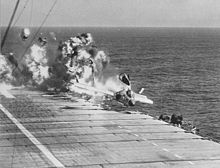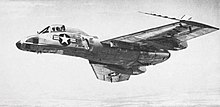Vought F7U Cutlass
The Vought F7U Cutlass was a United States Navy carrier-based jet fighter and fighter-bomber of the early Cold War era. It was a highly unusual, semi-tailless design, allegedly based on aerodynamic data and plans captured from the Arado company at the end of World War II, Vought designers denied any link to the German research at the time.[1] The F7U was the last aircraft designed by Rex Beisel, who was responsible for the first fighter ever designed specifically for the US Navy, the Curtis TS-1 of 1922.
Regarded as a radical departure from traditional aircraft design, the Cutlass suffered from numerous technical and handling problems throughout its short service career. The type was responsible for the deaths of four test pilots and 21 other U.S. Navy pilots. [1] Over one quarter of all Cutlasses built were destroyed in accidents. The poor safety record was largely the result of the advanced design built to apply new aerodynamic theories.
Design and development

The Cutlass was Vought's entry to a U.S. Navy competition for a new carrier capable day fighter opened on 1 June 1945. The requirements were for an aircraft that was able to fly at 600mph (966km/h) at 40,000ft (12,192m).[1] The design featured broad chord, low aspect ratio, swept wings, with twin wing-mounted tail fins either side of a short fuselage. The cockpit was situated well forward to provide good visibility for the pilot during aircraft carrier approaches. The design was given the company type number of V-346 and then the designation F7U when it was announced the winner of the competition. [1]
Pitch and roll control was provided by elevons; it is notable that Vought called these surfaces "ailevators" at the time. Slats were fitted to the entire span of the leading edge. All controls were hydraulic powered. The very long nose landing gear strut required for high angle of attack takeoffs was rather weak, and a collapse could seriously jeopardize the pilot's safety. The F7U was also largely let down by its underpowered Westinghouse turbojets, an engine which some pilots wryly observed put out less heat than the same company's toasters.
Operational history


Three prototypes were ordered in 1946, with the first example flying on 29 September 1948, piloted by Vought's Chief Test Pilot, J. Robert Baker. The maiden flight took place from Naval Air Station Patuxent River and was not without its problems. J. Robert Baker lost his life while flying the same aircraft a few weeks later when he lost control and crashed. During testing one of the protypes reached a maximum speed of 625mph (1,058km/h)[2]
Production orders were placed for the F7U-1 in a specification very close to the prototypes, and further developed F7U-2 and F7U-3 versions with more powerful engines. Because of development problems with the powerplant, however, the F7U-2 would never be built, while the F7U-3 would incorporate many refinements suggested by tests of the -1. The first 16 F7U-3s had non-afterburning Allison J35-29 engines. The -3 with its Westinghouse J46-WE-8B turbojets would eventually become the definitive production version, with 288 aircraft equipping 13 U.S. Navy squadrons. Further development stopped once the F8U Crusader flew.
The F7U bore the fleet nickname of the Gutless Cutlass in reference to its lack of engine thrust, consequently its carrier landing and takeoff performance was notoriously poor. The J35 was actually known to flameout in the rain, a very serious fault.
Blue Angels
The Blue Angels Navy aerobatics team flew two F7U-1 Cutlasses as a side act during their 1952 show season in an effort to promote the new aircraft, but did not use them as part of their regular formation act. Both the pilots and ground crews found the aircraft generally unsatisfactory and it was apparent that the type was still experiencing teething troubles.[2]
Variants
- XF7U-1
- Three prototypes ordered on 25 June 1946. First flight, 29 September 1948, all three aircraft were destroyed in crashes. [3]
- F7U-1
- The initial production version, 14 built. Powered by two J34-WE-32 engines.
- F7U-2
- Proposed version, planned to be powered by two Westinghouse J34-WE-42 engines with afterburner, but the order for 88 aircraft was cancelled.
- XF7U-3
- Designation given to one aircraft built as the prototype for the F7U-3. First flight: 20 December 1951.
- F7U-3
- The definitive production version, 192 built.

- F7U-3P
- Photo-reconnaissance version, 12 built. With a 25 in longer nose and equipped with photo flash cartridges none of these aircraft saw operational service, being used only for research and evaluation purposes. [3]
- F7U-3M
- This version was armed with the AIM-7 Sparrow air-to-air missile, 98 built. A total of 48 F7U-3 existing airframes were upgraded to F7U-3M standard. An order for 202 aircraft was cancelled.
- A2U-1
- Designation given to a cancelled order of 250 aircraft to be used in the ground attack role.
Operators

- United States Navy
Survivors
Seven F7U Cutlass are known to have survived.
- F7U-3 s/n 128451
- Located unrestored and incomplete at the Fred E. Weisbroad Aviation Museum/International B-24 Museum in Pueblo, Colorado. Its condition is poor.
- F7U-3 s/n 129554
- Purchased by Len Berryman from Geiger Field, Washington in May 1958 and displayed outside the Berryman War Memorial Park in Bridgeport, Washington from 1958 until 1992. In June 1992 it was sold to Tom Cathcart of Ephrata, Washington for restoration to eventual flying condition. This aircraft is currently undergoing restoration at the Museum of Flight in Everett, Washington.
- F7U-3 s/n 129642
- On display at the Wings of Freedom Aviation Museum at the Naval Air Station-Joint Reserve Base Willow Grove, Pennsylvania. The aircraft belonged to attack squadron VA-12 and was flown to Willow Grove in May 1957 to take part in an air show. Upon arrival the aircraft was stricken from active duty. It was given to the Navy Reserve as a ground training aircraft, and eventually placed as a gate guard in front of the base on US Route 611. The airframe has only 326.3 hours total time.

- F7U-3M s/n 129655
- On display at the National Museum of Naval Aviation in Pensacola, Florida.
- F7U-3 s/n 129685
- Located for many years at the collection of Walter Soplata in Newbury, Ohio.[4] Like most aircraft on this famous farm the aircraft appears complete, though it is exposed to the elements and unrestored.
- F7U-3 s/n 129565
- Was undergoing restoration for display at the USS Hornet (CV-12) Museum in Alameda, California. Has now been transferred to USS Midway (CV-41) Museum in San Diego, California for final restoration and display.
- F7U-3 s/n 128451
- Also at USS Midway (CV-41) Museum in San Diego, California. May be restored for later display
Specifications (F7U-3M)
Data from Jane's Encyclopedia of Aviation[5]
General characteristics
- Crew: 1
Performance
- Thrust/weight: 0.29
Armament
- Guns: 4× 20 mm (0.787 in) M3 cannons above inlet ducts, 180 rounds/gun
- Hardpoints: 4 with a capacity of 5,500 lb (2,500 kg), with provisions to carry combinations of:
- Missiles: AIM-7 Sparrow air-to-air missiles
See also
Aircraft of comparable role, configuration, and era
Related lists
References
Notes
Bibliography
- Angelucci, Enzo. The American Fighter. Sparkford, Somerset, UK: Haynes Publishing Group, 1987. ISBN 0-85429-635-2.
- Green, William and Pollinger, Gerald. The Aircraft of the World. London: Macdonald, 1955.
- Gunston, Bill. Fighters of the Fifties. Cambridge, UK: Patrick Stephens Limited, 1981. ISBN 0-85059-463-4.
- Taylor, John W. R. "Vought F7U Cutlass". Combat Aircraft of the World from 1909 to the Present. New York: G.P. Putnam's Sons, 1969. ISBN 0-425-03633-2.
- Taylor, Michael J.H., ed. "Chance Vought F7U Cutlass." Jane’s Encyclopedia of Aviation. New York: Crescent, 1993. ISBN 0-517-10316-8.
- Winchester, Jim, ed. "Vought F7U Cutlass". The World's Worst Aircraft: From Pioneering Failures to Multimillion Dollar Disasters. London: Amber Books Ltd., 2005. ISBN 1-904687-34-2.
